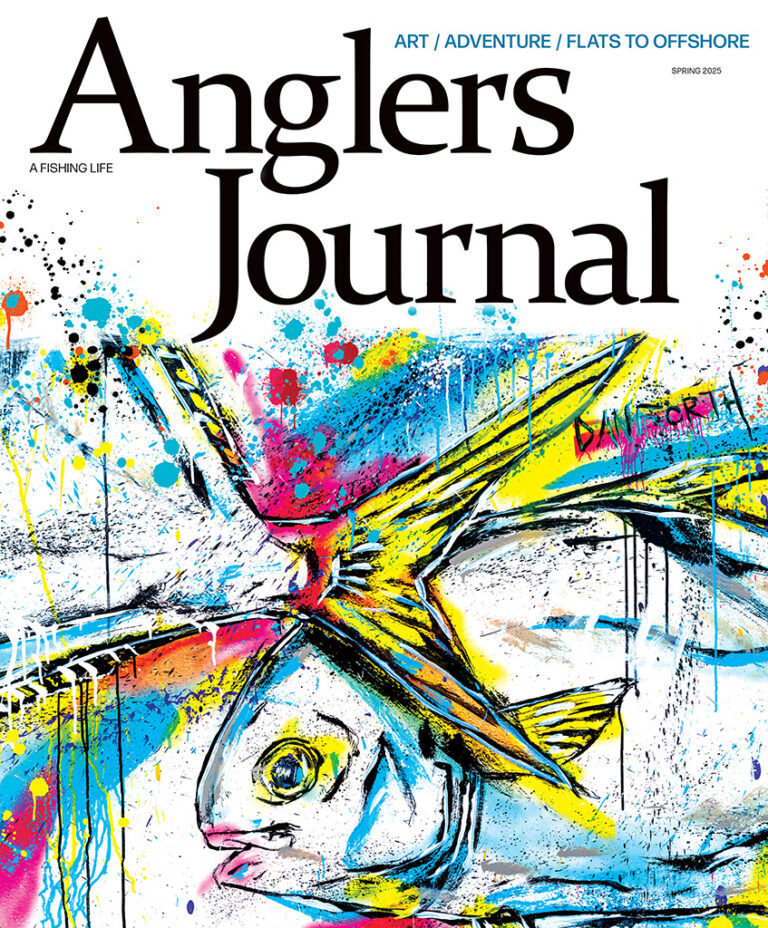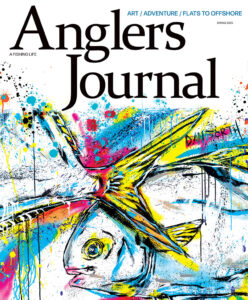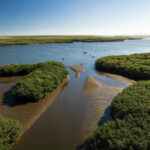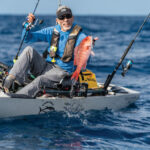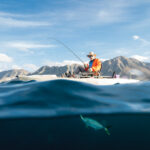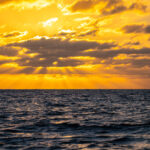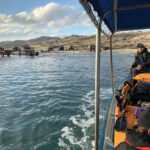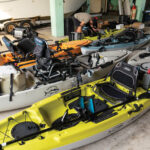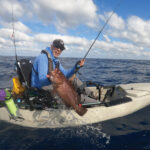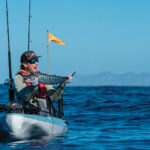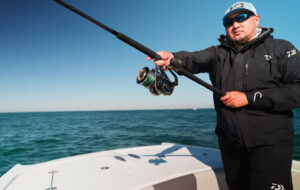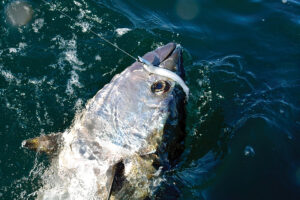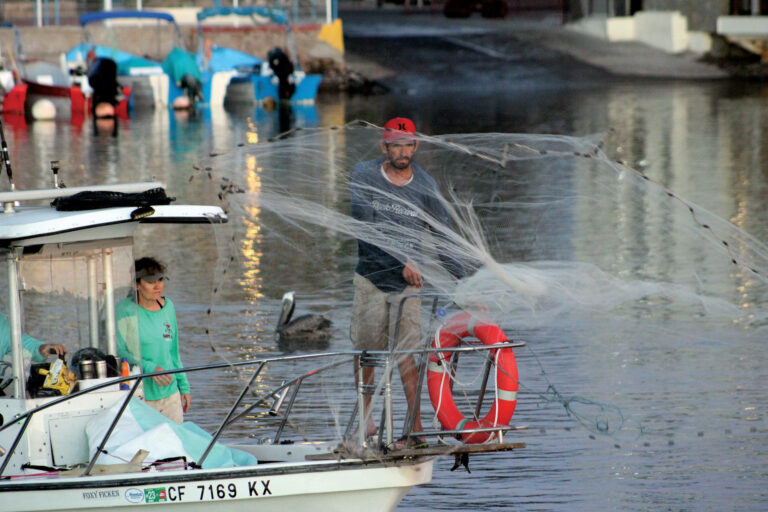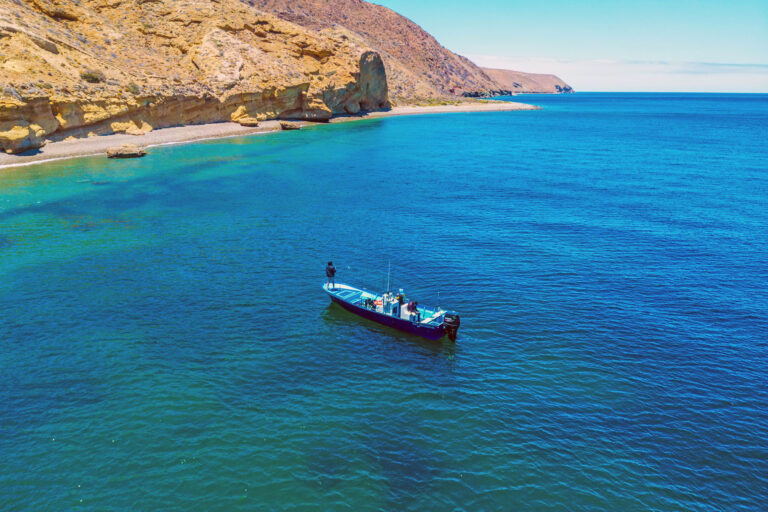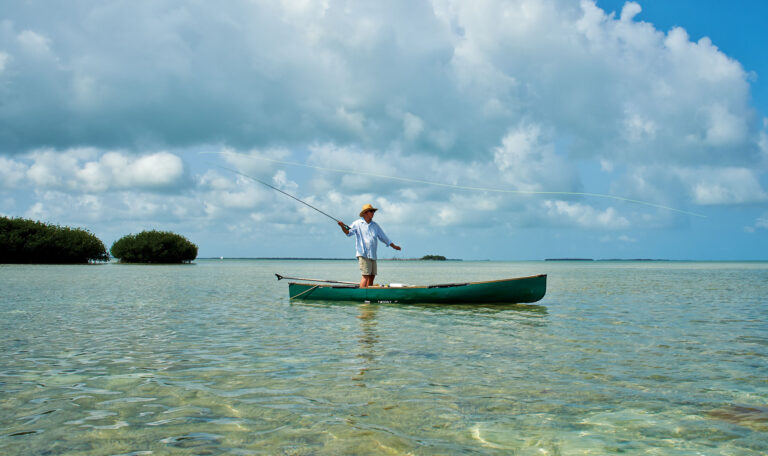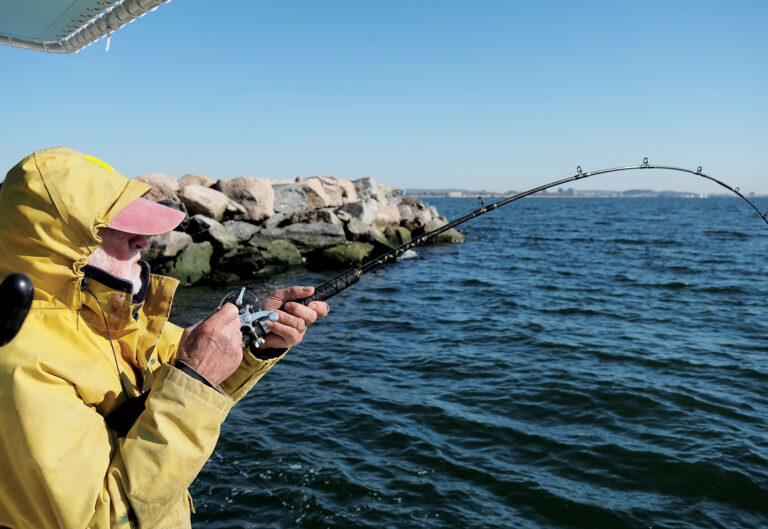 Doing battle with a striped marlin from a kayak typically results in a sleigh ride. All photos by Jeffrey Fortuna
Doing battle with a striped marlin from a kayak typically results in a sleigh ride. All photos by Jeffrey Fortuna“Get in! Get in!” Toby Larocque urged frantically as he and skipper Danny Infante slid a Hobie Pro Angler 14 off the panga’s gunwale and into the Pacific’s low ground swell. I put a foot in the middle of the kayak and in one quick motion swiveled to plop my butt down on the seat as Larocque leaned over the side to click a Mirage pedal-drive unit into its slots. Infante stuck a Daiwa Saltiga lever-drag reel in my face. I grabbed it, pushed off from the panga and pedaled hard as I free-spooled away from my lively 7-inch mackerel.
I caught sight of motion in the impossibly clear, cobalt water beneath the kayak, my eyes drawn to flashing pectoral fins and tails edged in electric cyan. The extraordinary display of so many striped marlin crisscrossing and on the hunt for prey was mesmerizing. I took it all in from a little plastic boat that weighs considerably less than I do, while rushing over the surface with no evident means of propulsion.
The engine that moved my kayak at several knots (enough to leave a wake) was a large striped marlin to which I was tethered with 50-pound braid and a 6/0 circle hook embedded securely in the corner of the fish’s mouth. Within a couple of minutes of hopping into the kayak, a savage strike had ripped line from the spool. I pushed up the lever drag on the Daiwa Saltiga and came tight immediately. At just about that instant, the big billfish burst high out of the water several times, leaping and twisting wildly. Then the sleigh ride began.
 The kayakers were brought offshore on pangas but fought the fish on their own.
The kayakers were brought offshore on pangas but fought the fish on their own.I wasn’t alone in this contest. I could hear shouting across the waves, as other kayak anglers, rods bent over hard, were pulled in various directions. The marlin pulled me through and over large bait balls, with frigate birds wheeling just overhead. Several times the fish towed me over flashing silver scales adrift after the carnage of marlin attacks.
I recall hearing Morgan Promnitz’s voice crackle over the VHF under my seat, as a stripey towed him toward the horizon: “Marc! Get over here! There must be 50 to 100 marlin all around me!” Daiwa’s Marc Mills was unable to follow that advice, as he was also hooked up.
There would be no stand-up fighting harnesses on this day; big-game angling from a kayak is all about arms and back, and the drag of the kayak. On kayaks smaller than the big Pro Angler — such as the Hobie Passport models from which two anglers fished — you can straddle the vessel with your feet in the water to increase resistance.
After more than an hour, I was able to bill the beast and work the circle hook out of its jaw, then pedaled for 10 minutes or so holding the marlin by its bill alongside until it was kicking strongly for a healthy release. I’ve caught many good fish in many places from kayaks over the decades, but none offered the level of satisfaction of my first Magdalena Bay marlin.
Packs of Marlin
From about 10 a.m. to 3 p.m., fishing 35 or so miles off Mag Bay’s southern entrance in Baja California, Mexico, four kayakeros released nine striped marlin. Promnitz, Hobie’s director of fishing development, managed four releases (helped by strong arms and 100-pound braid). As he fished, Promnitz “watched a school of large sardines get picked off one by one by a wolf pack of a dozen marlin, using body language and coloration to communicate as they took turns teaming up on the baitfish,” he told me later. “It was probably the most incredible experience I’ve ever had on the ocean, being able to see them from the stealth of a kayak that left them unaffected by my presence.”
 The pedal drives free up the kayakers hands when fighting fish, and reviving billfish.
The pedal drives free up the kayakers hands when fighting fish, and reviving billfish.Striped marlin gather in great numbers off Magdalena Bay during the fall and early winter, but its remote location, cutting deep into the mostly uninhabited Pacific side of the central Baja coast, keeps fishing pressure minimal. That creates truly special opportunities to experience packs of striped marlin in every direction and boiling at the surface, especially from a kayak.
Mag Bay Lodge is one of the few operations in the area that caters to anglers. Larocque, the owner, uses 26-foot pangas as mother ships to transport kayaks, anglers and gear within and outside the bay. He and his crew load two kayaks aboard each panga and head for a destination determined by anglers’ goals, the season and the morning’s conditions.
Once at the grounds, the kayaks slide easily off the panga’s low sides. With anglers launched, the pangas remain in proximity and in contact to bring bait, food and drinks, gear, or to pick up fish for dinner and put them on ice. Loading kayaks back aboard is as simple as the unloading, whether heading back to the lodge or to another fishing spot.
Memorable Thetis Bank
While shots at multiple marlin are primarily what draws anglers to Mag Bay, it’s hardly the only outstanding opportunity here. Within the massive bay, miles of mangroves, beaches, channels, sandbars and islets offer chances for snook, roosterfish, golden trevally, Colorado snapper, barred pargo, white seabass, yellowtail, halibut, corvina and more. Fishing the two broad bay mouths through which the Pacific ebbs and floods is not to be missed, either, as long as a kayakero is prepared to pedal hard against strong currents. These dramatic openings attract gamefish amidst spectacular surroundings — boiler rocks, sheer cliffs and herds of sea lions.
 The fishing in Mag Bay is diverse and plentiful. Seen here is Marc Mills with a nice yellowtail.
The fishing in Mag Bay is diverse and plentiful. Seen here is Marc Mills with a nice yellowtail. During our “inshore” days, we managed to catch many species fishing different areas in the bay. It quickly became evident that in Mag Bay, everything is far away. In terms of the run up, down or across the bay to reach the fishing grounds, the ride on the pangas seldom took less than 45 minutes and often was an hour or two. Fishing far offshore might take longer, particularly with a stiff headwind chop.
Some offshore destinations also require a boat ride across a sandy peninsula. That begs some explanation. It’s all about getting there — in this case, to Thetis Bank, about 30 miles off the northern part of Mag Bay. That’s the shortcut route; to boat down to the large mouth of the bay and then northwest to Thetis is more like 45 miles.
Our journey to Thetis had us leaving the lodge in two pangas at dawn for a 15-minute ride to a launch point of sorts on a shallow beach. There, an old and battered but serviceable red Ford pickup backed a trailer to waiting boats (artisanal fishing pangas except for us) to be shuttled a mile or so over the sand and dropped in at a beach facing the Pacific. Standard operating procedure called for fishermen to simply sit in their pangas for the short ride.
There was a small queue ahead of us, so we waited 20 or so minutes for each boat to be served. With four passengers, kayaks and lots of gear, our boat was heavier than the norm, but with mucho creaking, the truck pulled us out and only once required a stop to add air to a sagging tire with an old bicycle pump.
 A support team helps shuttle kayaks and anglers to the action surrounding Mag Bay.
A support team helps shuttle kayaks and anglers to the action surrounding Mag Bay.Action Top, Bottom and In Between
Once relaunched, we encountered a northwest wind, not yet brisk but enough to promise a slow, bumpy ride. When we reached Thetis Bank, the crew put us in over an 80-foot high spot, though wind and currents quickly moved the kayaks off. But we had a great morning with yellowfin tuna — small to maybe 20 pounds — and skipjack. I found spinners with 20- and 30-pound braid perfect for throwing poppers or Sebile Stick Shadds worked back fast and hard.
At one point, the crew in one panga shouted excitedly into the radio something about cow yellowfin swimming underneath the boat. Promnitz said later he might have been close enough to cast a jig to them. “But really, 200-plus-pound fish on 40-pound braid? What was the point?” he said. After catching and mostly releasing many tuna, I dropped slow-pitch jigs during the afternoon in 200 or so feet to catch Pacific red snapper, gulf grouper and various small reef fish. Nearby, Promnitz and Mills found good action on yellowtail to 25 pounds in mid-depths, fishing speed jigs.
By 3 p.m., seas were sporty and building. In other circumstances, I might have thought it was a good time to return to the panga, but I was having such a blast and had gotten so used to climbing up the swells and skating back down that I hardly gave the conditions a second thought. However, the crew soon gave us the high sign; with at least 2½ hours to get to the lodge, it was time to pack up.
The return trip took us perhaps 20 additional minutes when the wheel bearings in the old trailer failed halfway across the sand. We hopped out and lifted the bow while the driver pulled the truck away, unhooked the trailer and soon arrived with another old trailer. We hefted the bow to accommodate the new trailer he backed down, and soon we were again in the water, on the inside, headed back to the lodge under the rising full moon. It’s all part of the adventure when kayak-fishing Magdalena Bay.

